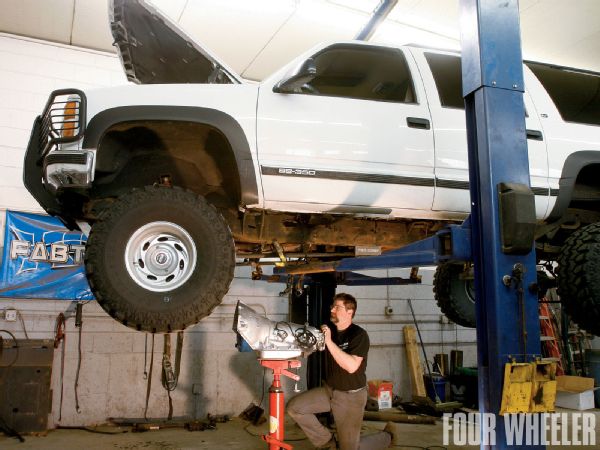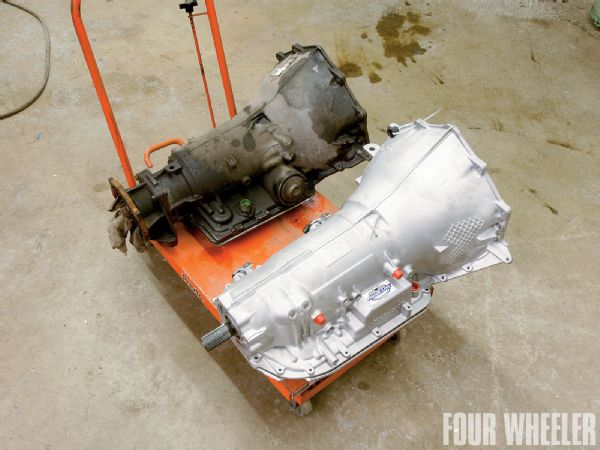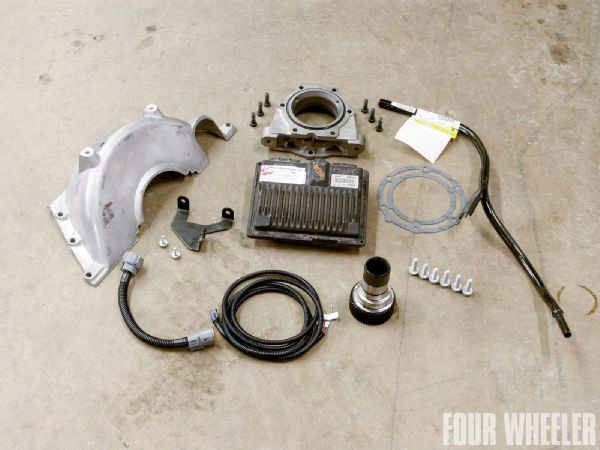
 Ken Brubaker
Senior Editor, Four Wheeler
Ken Brubaker
Senior Editor, Four Wheeler
This 1997 Chevy Suburban has a 5.7-liter engine, 6-inch suspension lift, and 35-inch tires. The truck is regularly used off-highway and to tow trailers. It also has a propensity for killing its 4L60E four-speed automatic transmission.

The 4L60E transmission has been used in a slew of 1/2-ton GM trucks and SUVs, and it has even appeared in some GM 3/4-ton trucks. It's a decent transmission that has proven itself a workhorse. However, if you use your truck hard, it can be a weak point that can fail-in some cases, repeatedly.
The owner of this rig could've kept paying to have the 4L60E rebuilt, but instead chose to replace it with the much beefier 4L80E four-speed automatic transmission. The 4L80E has been used in a number of 1/2-, 3/4-, and 1-ton GM trucks over the years. Upgrading from the 4L60E to the 4L80E is akin to going from a Dana 44 axle to a Dana 60--you'll add some weight, but also add durability. According to GM Powertrain information, the 4L60E has a maximum engine torque rating of 360 lb-ft and a maximum gearbox torque rating of 610 lb-ft. The 4L80E has a maximum engine torque rating of 440 lb-ft and a maximum gearbox torque rating of 885 lb-ft. What this boils down to is that the 4L80E offers an 80 lb-ft and 275 lb-ft improvement over the 4L60E in both areas, respectively. Is there a downside? Well, the 4L80E is slightly heavier and offers a less crawly First gear ratio (2.48:1) than the 4L60E (3.06:1).
 Here you can see the old 4L60E transmission next to the new 4L80E. The 4L80E we installed was built by Finish Line Transmissions in Wood Dale, Illinois. It's their Level 3 Street Performance unit, which features a number of upgrades and enhancements to improve performance and durability. With torque converter, the new 4L80E tipped our scales at 254 pounds dry. By contrast, the 4L60E weighed in at 182 pounds wet.
Here you can see the old 4L60E transmission next to the new 4L80E. The 4L80E we installed was built by Finish Line Transmissions in Wood Dale, Illinois. It's their Level 3 Street Performance unit, which features a number of upgrades and enhancements to improve performance and durability. With torque converter, the new 4L80E tipped our scales at 254 pounds dry. By contrast, the 4L60E weighed in at 182 pounds wet.
Matt Dinelli and his team at Attitude Performance in Arlington Heights, Illinois, have completed a number of 4L80E swaps on fullsize GM trucks. We recently had the chance to witness one of these swaps on the aforementioned vehicle. Here are the highlights.
 Shown here are the components needed to complete the swap, sans transmission and driveshaft. There's a new inspection cover, transfer case adapter with hardware, new filler tube, reflashed ECM, transmission shifter cable bracket with hardware, 4L60E-to-4L80E jumper harness, speed sensor harness, and a larger-diameter transfer case input shaft.
Shown here are the components needed to complete the swap, sans transmission and driveshaft. There's a new inspection cover, transfer case adapter with hardware, new filler tube, reflashed ECM, transmission shifter cable bracket with hardware, 4L60E-to-4L80E jumper harness, speed sensor harness, and a larger-diameter transfer case input shaft.
Bottom Line
The total price of this particular swap was a hair under $4,200. This included the complete transmission with torque converter (about $2,300), all of the conversion components, front driveshaft, and labor. Keep in mind that this figure was for this specific rig, and costs can vary significantly by vehicle and the price of the transmission and torque converter being installed. If you're a do-it-yourselfer, a kit is available from Attitude Performance for approximately $700. It includes everything listed in the first-captioned photo at the beginning of the story.


 PhotosView Slideshow
PhotosView Slideshow


 PhotosView Slideshow
PhotosView Slideshow


 PhotosView Slideshow
PhotosView Slideshow


 PhotosView Slideshow
PhotosView Slideshow


 PhotosView Slideshow
PhotosView Slideshow


